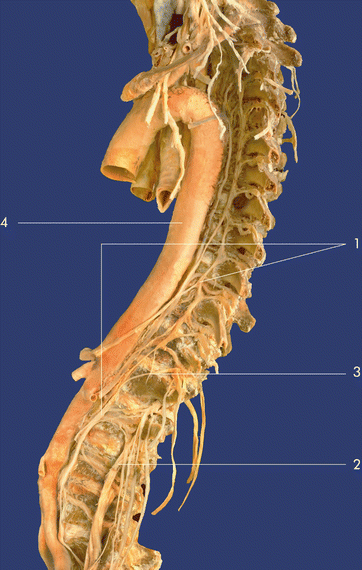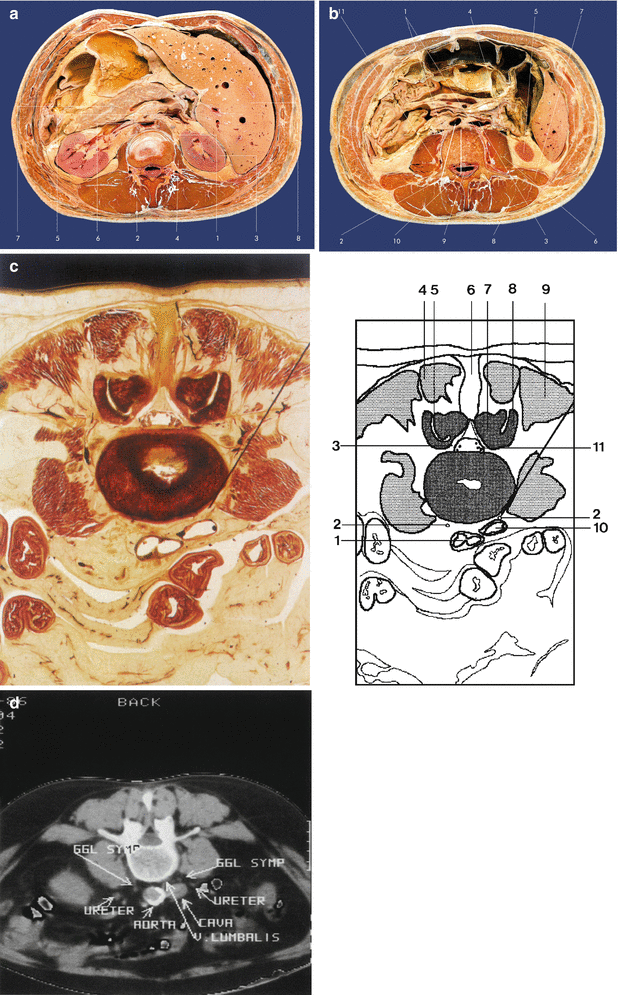Fig. 45.1
Anatomy (anterior view): (1) sympathetic trunk with communicating branches, (2) lumbar plexus, (3) lumbosacral trunk, (4) quadratus lumborum muscle, (5) psoas major muscle, (6) iliac muscle (Reproduced with permission from Danilo Jankovic)

Fig. 45.2
Anatomy.(1) Lumbar sympathetic chain, with its accompanying ganglia, (2)somatic paravertebral nerves, (3) rami communicantes, (4) aorta (Reproduced with permission from Danilo Jankovic)

Fig 45.3
(a) Lumbar sympathetic block. Cross -sectional anatomy at the level of L1, L2. (1) Sympathetic ganglion, (2) erector spinae muscle, (3) medulla renalis, (4) psoas major muscle, (5) inferior vena cava, (6) aorta, (7) pancreas, (8) liver (Reproduced with permission from Danilo Jankovic). (b) Lumbar sympathetic block. Cross- sectional anatomy at the level of L3. (1) Sympathetic trunk, (2) aorta, (3) inferior vena cava, (4) ureter, (5) kidney, (6) psoas major muscle, (7) quadratus lumborum muscle, (8) erector spinae muscle, (9) cauda equina, (10) anterior longitudinal ligament, (11) lumbar plexus (Reproduced with permission from Danilo Jankovic). (c) Lumbar sympathetic block (anatomy and diagram). (1) Aorta, (2) sympathetic ganglion, (3) epidural space, (4) medial tract of back muscles, (5) intervertebral joint, (6) interspinal ligament, (7) superior articular process of L3, (8) inferior articular process of L4, (9) lateral tract of back muscles, (10) vena cava, (11) filum terminale (Reproduced with permission from Danilo Jankovic). (d) CT section in the center of the L4 vertebra. The sympathetic ganglia are well delineated in the fatty tissue on each side. Neighboring structures, such as the vessels and ureters, can also be precisely differentiated
From the T12 ganglion, the sympathetic trunk passes into the abdominal cavity. The abdominal part of the trunk reaches the anterolateral surface of the lumbar vertebrae, lying directly medial to the origin of the psoas, to the right behind the inferior vena cava and cisterna chyli, and to the left beside the aorta. The lumbar part of the sympathetic trunk usually contains only four lumbar ganglia (due to fusion of the twelfth thoracic and first lumbar ganglion), with a spindle shape or oval shape. The final ganglion is usually the largest.
The average length of the ganglia is ca. 3–5 mm (more rarely, up to 10–15 mm). The psoas muscle and its fascia separate the sympathetic nerve trunk from the lumbar somatic spinal nerves.
The sympathetic trunks give off and receive communicating and visceral branches, as well as vascular, muscular, osseous, and articular branches.
White communicating branches only reach the lumbar sympathetic ganglia from the two cranial spinal nerves, as well as from the three lumbar spinal nerves. They carry preganglionic fibers and visceral afferents. Gray communicating branches are given off from the corresponding ganglia to all the lumbar spinal nerves. They contain vasomotor, sudomotor, and pilomotor fibers, which are distributed with the lumbar spinal nerves. From the lumbar part of the sympathetic chain, some branches run to the renal plexus, but most pass to the abdominal aortic plexus and the hypogastric plexus. Most of the sympathetic nerve fibers responsible for the lower extremity pass through the L2 (dominant) and L3 ganglia.
Indications [6–9]
Diagnostic and Prognostic
Differentiation between various forms of vasospastic disease in the area of the lower extremities
Prognostic block to establish an indication for surgical sympathectomy or a neurolytic block
Checking (confirmation) of a surgical sympathectomy
Therapeutic
Pain caused by perfusion disturbances in vasospastic diseases in the region of the lower extremities, in the form of arterial or venous dysfunction or a combination of the two
Intermittent claudication
Embolism and thrombosis
Thrombophlebitis and post-phlebitic edema
Post-reconstructive vascular procedures
After frostbite or trauma
Complex regional pain syndrome (CRPS) types I and II
Phantom limb pain
Erythromelalgia
Acrocyanosis
Phlegmasia alba dolens (milk leg)
Persistent infection of the leg
Poorly healing ulcers
Neuropathy after radiotherapy
Hyperhidrosis of the lower body
Acute phase of herpes zoster
Visceral pain (e.g., renal colic)
Block Series
A series of six to eight blocks is recommended. When there is evidence of improvement in the symptoms, additional blocks can also be carried out.
Contraindications
1.
Anticoagulant treatment
2.
Infections and skin diseases in the injection area
3.
Addition of vasopressors in patients with peripheral circulatory disturbances
Procedure [1–5]
This block should only be carried out by experienced anesthetists or under their supervision. Full information should be given to the patient.
Preparations
Check that the emergency equipment is complete and in working order; sterile precautions, intravenous access, ECG monitoring, pulse oximetry, intubation kit, ventilation facilities, emergency medication.
Materials
Fine 26-G needle, 25 mm long, for local anesthesia. Atraumatic 22-G needle, 0.7 × 120 mm (15°) with injection lead or spinal needle, 0.7 (0.9) × 120 mm (150 mm), 20–22 G Syringes: 2, 5 and 10 mL.
Disinfectant, swabs, compresses, sterile gloves and drape, flat, firm pillow.
Patient Positioning
1.



Prone position: support with a pillow in the mid-abdomen (to eliminate lumbar lordosis). The patient’s arms should be dangling.

Full access? Get Clinical Tree








